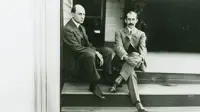Economic history – the Roaring Twenties – Part 3
By Kiron Kasbekar | 01 Mar 2024
.jpg)
In the first part of this story, ‘The Roaring Twenties-1’ we saw how the economies of America and Europe bounced back, and created revolutionary new products, such as remarkable new cars and aeroplanes, and how road networks were expanded, giving greater space for the cars, buses, and trucks.
In the second part of this story, ‘The Roaring Twenties-2’ we talked about how more new products were launched for homes, including record players, washing machines, and vacuum cleaners.
This part, the third and last part, will look briefly at the new cultural styles that flourished, including jazz and swing in America, and the rebellious art scene in Europe. The world had recovered not only from the First World War, in which an estimated 20 million people were killed but also from the Spanish Flu, which killed between 25 and 50 million people worldwide.
As the decade of the 1920s arrived, the mood in the West was lifted. Life was all fun, entertainment, and new products. Sadly, towards the end of the decade, everything crashed. But read on. For whatever might have happened later, until that crash, the decade was perhaps the most eventful decade in which the word ‘event’ did not mean ‘war’ or ‘pandemic’.
Vibrancy and verve
But it wasn’t just material goods that defined the Roaring Twenties. The decade was marked by a profound shift in values, lifestyle, and attitudes as it negotiated unprecedented cultural and social change.
The change reflected a marked population shift from rural to urban areas. While India was at a low of 10.9% urbanization and China even lower, at 6.5%, the UK, France, and Germany were already at much higher levels (see table). The US came up from behind and became a power to reckon with.
Urban population percentages
| Year | UK | US | France | Italy | Germany | Brazil | Iraq | Egypt | India | China |
| 1900 | 62.22 | 39.60 | 45.52 | 32.92 | 21.80 | 22.94 | 22.29 | 21.04 | 10.90 | 6.50 |
| 1910 | 65.57 | 45.60 | 47.45 | 37.01 | 27.26 | 25.13 | 24.41 | 23.05 | 10.30 | 6.56 |
| 1920 | 68.92 | 51.20 | 49.37 | 41.28 | 34.07 | 27.52 | 26.73 | 25.24 | 11.20 | 6.63 |
| 1930 | 72.28 | 56.19 | 51.29 | 45.46 | 42.59 | 30.14 | 29.28 | 27.65 | 12.00 | 7.00 |
| Country | Urbanization growth % (1900-1930) |
| Germany | 95 |
| US | 42 |
| Italy | 38 |
| Brazil | 31 |
| Iraq | 31 |
| Egypt | 31 |
| UK | 16 |
| France | 13 |
| India | 10 |
| China | 8 |
The rapid urbanization, along with the great industrialization some of these countries had experienced, resulted in major cultural changes, which varied from country to country. America embraced the stock markets, jazz and swing, and a consumerist boom, and Western Europe was not far behind.
With the widespread use, for the first time, of automobiles, telephones, radio, movies, and electrical appliances by millions, the young in the Western world were experiencing an unprecedented sense of cultural liberation. Gone were the staid attires, the stuffy conversations in polite society, and the overall seriousness with which people took life - to be replaced by frivolity, experimentation, and adventure.
There was more fun and dance in life compared with the relatively staid lifestyles of the past, at least for the upper and middle classes. New things were being discovered and new technologies were being harnessed. The art world too reflected the vibrancy and verve.
Gramophone and radio
Soon, electrical recording of sound was invented, and gramophone records, which had entered the market around 1912 and replaced phonograph cylinders, came to the market in 1925.
With the advent of the radio and the gramophone, the music industry boomed. People didn’t have to be physically present at a venue where musicians played their numbers. They could relax in their homes and listen to the music coming from radio stations of their choice, or listen to the music of their choice from the record players in the house.
.jpg)
Nowhere was this more evident than in America. In America, the Roaring Twenties were also known as the Jazz Age. Musicians such as Duke Ellington, and Ella Fitzgerald, enthralled listeners with their music and encouraged even more musicians to follow their examples. Swing dancing was another rage during this period.
News and entertainment at home
Today we think of the radio as an archaic form of news and entertainment. But imagine the excitement that people must have felt when they first saw a radio and heard voices and music emerging from the lifeless gadget. Many people looked upon it as something magical! Until it soon became so common that people didn’t think about it or discuss it with awe; they just turned the dials and played it!
In the mid-1920s, better vacuum tubes changed how radios worked. People like John Ambrose Fleming and Lee de Forest made these improvements possible. Before, radios used carbon microphones to send out signals, but then companies like Westinghouse improved the tubes, making radios work better.
.jpg)
In 1926, a big change came with the ‘battery eliminator’. It meant radios could run without big batteries. By 1927, radios didn’t need batteries at all, thanks to new tube designs.
.jpg)
Radio was welcomed as a mass broadcasting medium; the first broadcasting medium. Radios were expensive at first, but they became a compulsive habit for those who could afford them. Prices reduced over time and more homes were able to buy them. With radio came radio advertising, which became a vital mass medium for advertising and marketing.
The US emerged as a pioneer in radio broadcasting during the 1920s, which saw the establishment of the first commercial radio stations. Initially, stations focused primarily on broadcasting music concerts, religious services, and educational lectures. Radio news broadcasting began to take shape in America during the 1920s. Stations started airing news bulletins, often reading from wire service reports or newspapers. Popular programs included variety shows, comedy sketches, soap operas, and live music performances. Radio broadcasting helped the spread of popular music genres such as jazz and blues, contributing to the ‘Roaring Twenties’ cultural phenomenon. Radio also played a role in political campaigns and advertising, influencing public opinion and consumer behavior.
Europe too embraced radio broadcasting enthusiastically during the 1920s, with variations across different countries due to political, social, and economic factors.
In the United Kingdom, the British Broadcasting Company (BBC) was founded in 1922; laying the foundation for public broadcasting. The BBC initially focused on providing educational and informative content, including news bulletins, music, and other cultural programs and educational programming.
In Germany, radio broadcasting expanded rapidly during the 1920s, with both public and private stations airing programming. The Weimar Republic saw a flourishing of radio culture, with avant-garde programming, experimental music, and political commentary.
In France, radio broadcasting grew rapidly in the 1920s with the establishment of Radio Paris in 1922 and Radio Tour Eiffel in 1925. These stations broadcast news, music, and cultural programming.
In Italy, radio broadcasting was launched in 1924 and expanded under the fascist regime of Benito Mussolini, serving as a propaganda tool for the regime.
Across Europe, other countries like Spain, the Netherlands, and Switzerland saw the establishment of radio stations and the development of broadcasting infrastructure. Radio became a symbol of modernity and progress, connecting communities and shaping public opinion.
In Asia, Japan emerged as a pioneer in radio broadcasting, airing news programs, cultural shows, and educational content, contributing to the modernization of Japanese society.
In Latin America, radio broadcasting gained popularity during the 1920s in countries like Argentina, Brazil, and Mexico. Commercial stations proliferated, airing music, drama, and sports coverage. In Mexico, radio played a significant role in the cultural and political movements of the period.
Radio broadcasting made limited inroads in Africa during the 1920s, primarily in colonial territories under European control. Stations operated by colonial authorities focused on promoting colonial interests.
It didn’t take long for radio broadcasting to spread from the West to countries like India.
In 1923 hobbyists launched India’s first radio station in Bombay, and others did so in Calcutta in the same year, and in Madras in 1924. These clubs broadcast brief news snippets and prerecorded concerts for a limited period each week.
They were not able to sustain their effort, and the British government of India stepped in and created the Indian Broadcasting Service in 1930. The service was renamed as All India Radio in 1936 and as Akashvani in 1957.
Crazy, entertaining years
In France, they called the 1920s Les Années Folles, or ‘crazy years’. Paris became the hub for writers and artists, who created great new works. They included people from other countries who settled down in Paris – the Lithuanian Chaïm Soutine, the Italian Amedeo Modigliani, and the Russian Marc Chagall who had immigrated to Paris in that period.
The painters who settled in the city were known as the École de Paris (or ‘School of Paris’), although there was no ‘school’ as such, neither a building nor a common art style. It was just a rebellious new way of thinking. The artists mostly found residences and studios in the Montparnasse area of the city and included some of the best-known artists of that period.
While Paris was undoubtedly a cultural hub of the Roaring Twenties, other European cities also experienced their own artistic and cultural developments during this period:
In Britain, London’s cultural scene literary and artistic personalities and academic figures like Virginia Woolf, E. M. Forster, Lytton Strachey, Vanessa Bell, and John Maynard Keynes were active in the 1920s.
Berlin was another vibrant center of cultural innovation. The city’s nightlife, cabaret scene, and expressionist art were influential. Figures like George Grosz and Otto Dix created powerful and satirical artworks that reflected the social and political turmoil of the time.
Vienna continued to be a center for intellectual and artistic activity. This Austrian city was home to writers such as Franz Kafka and musicians like Arnold Schoenberg.
In Spain, the 1920s saw the flourishing of the avant-garde movement in literature and art. Figures like Federico García Lorca and Salvador Dalí emerged as prominent voices in Spanish culture.
The new medium, cinema
During the 1920s cinema as a medium boomed, offering a new form of entertainment to an eager public. Cinema successfully competed with theatre and vaudeville. Many theatre actors were attracted to the movie industry, lured by money and fame.
The early movies were silent cinema; the ‘talkies’ emerged during the mid-1920s. The first feature-length movie with synchronized sound, Don Juan, was inspired by the epic poem of the same name written by George Gordon Byron, better known as Lord Byron, in 1821. While the movie, Don Juan, was launched by Warner Bros in 1926, it did not have any spoken dialogue, it used the Vitaphone sound-on-disc sound system with a synchronized musical score and sound effects.
.jpg)
In 1923, American electronic inventor Lee de Forest introduced sound to short films via what he called ‘Phonofilm’, and his compatriot chemist Theodore Case developed the ‘Movietone’ sound-on-film system, selling rights to Fox Film. Warner Brothers’ ‘Vitaphone’ system followed in 1926.
.jpg)
Landmark success came in 1927 with the launch of The Jazz Singer, which used the Vitaphone system. While mostly relying on a musical score, it featured live-recorded audio during key moments, including Al Jolson’s singing and two ad-libbed scenes. Profits soared, and the film’s success convinced the industry of the viability of using sound. This breakthrough marked a pivotal shift in filmmaking, forever altering the cinematic landscape.
.jpg)
The 1920s were a golden age for the film industry, with Hollywood emerging as the global center of movie production. The era witnessed the rise of iconic film stars like Charlie Chaplin, Buster Keaton, and Clara Bow.
.jpg)
The rest of the world struggled
The Roaring Twenties were almost entirely a European and American experience, characterized as that period by economic prosperity, cultural transformation, and vital changes in social behavior. The rest of the world was far removed from these changes.
India, for example, was still under British colonial rule, and the struggle for independence, led by Mahatma Gandhi, was gaining momentum. But it was not just a political upheaval. Indian society was changing in many ways, with traditions slowly yielding to modern ways.
The Indian film industry was taking its baby steps, during this period. Men played women’s roles, much like earlier times in Britain, when Shakespearean plays had boys and men playing female roles. New literature was created in various Indian languages, and a small number of men had begun to speak English and wear Western clothes.
China, in the meanwhile, was experiencing the tumultuous Warlord Era during the 1920s. Following the fall of the Qing Dynasty in 1912, that country had broken up into numerous regional power centers controlled by warlords who ruled through sheer force. There was political instability as well as violence. But there was a growing sense of nationalism, especially after the May Fourth Movement of 1919, which protested the Treaty of Versailles, which allowed Japan to retain Chinese territories.
Japan saw a degree of political liberalization and the emergence of a more democratic system of governance. The country experienced a cultural renaissance during the 1920s. The era produced notable authors and artists who blended traditional Japanese aesthetics with modern influences.
Most other countries in Asia were under British, French, and Dutch colonial rule during the 1920s. There were widespread anti-colonial sentiments and resistance movements had begun to gain traction in some regions.
In other parts, the pace of modernization was strong. Turkey, led by Mustafa Kemal Atatürk, embarked on a program of secularization and modernization after World War I. The country adopted the Latin alphabet and implemented wide social reforms.
Then came the crash
While all these things were happening, and the young were dancing to tunes like the ‘All That Jazz’ sung in the movie, ‘Chicago’, as if there was never going to be an end to the fund and frolic, the world crashed around them.
.jpg)
For while the young were having fun, older people were so busy playing the stock markets that the prices rose to dizzy heights. Heights from they had nowhere else to go but down.
The American stock markets crashed after a decade of speculative buying. The gains that had been made from the beginning of the 1920s were completely wiped out over the next two years.
Can you imagine what happens when people lose 80% of their wealth? Panic! Chaos! That’s what happened. About this, we shall have another article soon.
What can one say about these events except that they showed how foolish people were, despite all the new science, technology, and education the world had had? Greed overcame everything else.



















